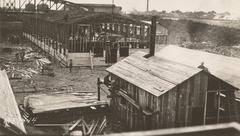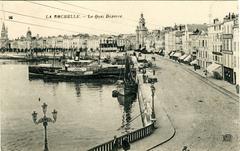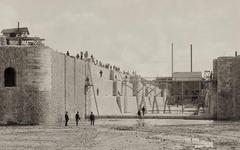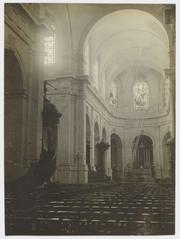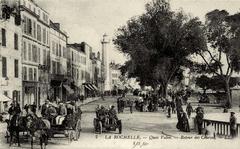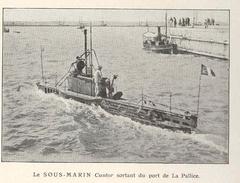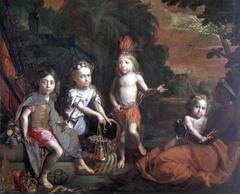Toussaint Louverture Statue in La Rochelle: Visiting Hours, Tickets, and Travel Guide
Date: 14/06/2025
Introduction
The Toussaint Louverture statue in La Rochelle stands as a compelling monument to one of the most consequential figures in the fight against slavery and for Black emancipation. Located in the courtyard of the Musée du Nouveau Monde—a site with its own deep ties to France’s colonial and slave-trading history—this 2.8-meter bronze sculpture by Senegalese artist Ousmane Sow invites visitors to reflect on the legacies of colonialism, resistance, and human rights. La Rochelle, once France’s second largest slave port, now confronts its past through such memorials, transforming historical spaces into places of education and remembrance. This guide provides comprehensive information on visiting the statue, including practical details, historical context, and recommendations for nearby attractions.
Table of Contents
- Introduction
- About the Toussaint Louverture Statue
- Visiting Hours and Ticket Information
- Highlights and Photographic Spots
- Nearby Historical Sites and Attractions
- Historical Significance of Toussaint Louverture
- Interpretive Features and Symbolism
- Community Engagement and Annual Commemorations
- Frequently Asked Questions (FAQ)
- Plan Your Visit
- Summary and Recommendations
- Sources and Further Reading
About the Toussaint Louverture Statue
The striking bronze statue of Toussaint Louverture, created by internationally acclaimed Senegalese artist Ousmane Sow, was inaugurated in 2015 in the courtyard of the Musée du Nouveau Monde. Louverture is depicted dressed in the uniform of a French governor, reading the Constitution of Saint-Domingue—a document that signaled the autonomy of the colony and laid the groundwork for modern Haiti (Musée du Nouveau Monde, France 3 Régions).
The statue’s location is deeply symbolic. The museum occupies the former Hôtel Fleuriau, a mansion built by a family whose fortunes were tied to the slave trade. The monument’s presence here visually and thematically reclaims the space, inviting reflection on the city’s historical legacy.
Visiting Hours and Ticket Information
- Location: Musée du Nouveau Monde, 10 rue Fleuriau, 17000 La Rochelle, France
- Opening Hours: Tuesday to Sunday, 10:00 AM – 6:00 PM; closed on Mondays and certain public holidays
- Admission: €6 for adults; discounts for students, seniors, and free entry for children under 18
- Tickets: Purchase at the museum or online via the official website
- Accessibility: The museum and courtyard are wheelchair accessible; assistance is available upon request
- Guided Tours: Tours focusing on the statue’s symbolism and the history of slavery and abolition can be booked in advance
For up-to-date information, see the Musée du Nouveau Monde website.
Highlights and Photographic Spots
The museum’s elegant 18th-century façade provides a powerful contrast to the modern symbolism of the Louverture statue. The courtyard offers ample space for contemplation and photography, allowing visitors to capture the monument from multiple perspectives. Special exhibitions on Haitian art, the Atlantic slave trade, and abolition are often held at the museum, providing further context.
Nearby Historical Sites and Attractions
Enhance your visit to La Rochelle with these nearby highlights:
- Old Port of La Rochelle: Historic harbor, site of maritime trade and city life
- La Rochelle Maritime Museum: Explore the city’s rich seafaring history
- La Rochelle Cathedral: A Gothic church reflecting religious and civic heritage
- La Rochelle Aquarium: One of Europe’s largest, suitable for family visits
For additional attractions and travel tips, visit the La Rochelle Tourism Office.
Historical Significance of Toussaint Louverture
Toussaint Louverture (1743–1803) was born enslaved in Saint-Domingue (modern Haiti). He rose to lead the only successful large-scale slave revolt in modern history, ultimately achieving the abolition of slavery and laying the foundation for Haiti’s independence in 1804 (Château de Joux, V&A Blog). His leadership, intellect, and vision made him a global symbol of resistance and emancipation. Despite his eventual arrest and death in France, Louverture’s legacy endures through monuments, annual commemorations, and educational initiatives.
Interpretive Features and Symbolism
Artistic Vision and Composition
Ousmane Sow designed the statue to be larger than life (2.8 meters tall), with Louverture captured in a moment of dignified resolve as he reads the constitution. The sculpture’s textured bronze surface highlights Louverture’s expressive features, the folds of his uniform, and his commanding posture. One hand holds the constitution, signifying his intellectual and political contributions, while his forward gaze and stance convey determination (Montmartre Secret, Smithsonian Magazine).
Symbolic Placement
The statue’s installation in the courtyard of a former slave trader’s mansion in a city that profited from the Atlantic slave trade is a deliberate act of memory and reconciliation. By honoring Louverture—a figure of resistance and intellect—in this context, La Rochelle acknowledges its past and affirms its commitment to remembrance and justice (Mémoire Esclavage).
Community Engagement and Annual Commemorations
The statue’s inauguration in 2015 was a collaborative effort involving local officials, Haitian dignitaries, and heritage organizations such as Mémoria and Mémoires et Partages. The event underscored the statue’s significance for African and Caribbean diasporas, as well as the broader La Rochelle community.
Annually, on May 10th, France observes the National Day of Remembrance of the Slave Trade, Slavery, and Their Abolitions. La Rochelle hosts ceremonies and educational programs at the museum and statue, positioning the site as a focal point for dialogue and reflection (Sud Ouest).
Frequently Asked Questions (FAQ)
Q: Are there any entrance fees specifically for the Toussaint Louverture statue?
A: No, access to the statue is included with museum admission.
Q: What are the museum’s opening hours?
A: Tuesday to Sunday, 10:00 AM to 6:00 PM; closed Mondays and public holidays.
Q: Is the site accessible for visitors with disabilities?
A: Yes, the museum and courtyard are wheelchair accessible.
Q: Are guided tours available?
A: Guided tours can be arranged through the museum and local associations, with a focus on the statue and La Rochelle’s slave trade history.
Q: Can I photograph the statue and museum?
A: Yes, non-flash photography is permitted throughout the courtyard and museum.
Plan Your Visit
- Address: Musée du Nouveau Monde, 10 rue Fleuriau, 17000 La Rochelle, France (Google Maps)
- Transport: The museum is centrally located, within walking distance from the Old Port and accessible by public transit, with parking nearby.
- Tickets and Booking: Purchase on-site or via the official museum website.
- Visitor Resources: Download the Audiala app for guided tours and updates on exhibitions.
For the latest information on opening hours, ticket prices, and events, consult the Musée du Nouveau Monde and La Rochelle Tourism Office.
Summary and Recommendations
The Toussaint Louverture statue is not only a remarkable work of art but also a vital site of memory and education in La Rochelle. Its presence challenges residents and visitors alike to reflect on the intertwined histories of France, Haiti, and Africa, and to honor the struggles for justice and freedom. The accessibility, historical context, and proximity to other cultural sites make it an essential destination. Enhance your visit by exploring related landmarks along the “Mémoires rochelaises du Commerce Triangulaire” trail, attending annual commemorations, and utilizing available digital resources for a deeper understanding.
Sources and Further Reading
- Musée du Nouveau Monde – Toussaint Louverture Statue
- France 3 Régions – La Rochelle’s Toussaint Louverture Statue
- Château de Joux – Toussaint Louverture Biography
- V&A Blog – In Memory of Toussaint Louverture
- La Rochelle Tourism Office
- Mémoire Esclavage – Statue Toussaint Louverture La Rochelle
- Montmartre Secret – Toussaint Louverture par Ousmane Sow
- Smithsonian Magazine – A Larger Than Life Toussaint Louverture
- Sud Ouest – Mémoire de l’Esclavage: Qui était Toussaint Louverture?

